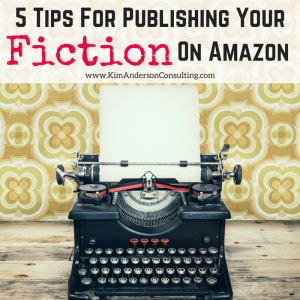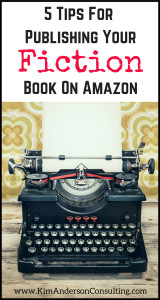Kindle Direct Publishing has opened so many doors that previously were closed to would be amateur authors. In the past, your work would have to be pitched to a number of publishers. The only guarantee would be to go to one of the many vanity publishers who would charge an arm and a leg to get your work out there. Now, with little effort and no cost, you can get your work in front of millions of potential readers. The question that I had was how to get started.
I backed into self publishing nearly by accident. I wrote mainly for my own entertainment. A classmate of mine from college had recently published a few novels on Amazon and encouraged me to give it a try. With a bit of trial and error, I managed to get my first novel published. There are a number of things that I would have done differently. Hopefully, these tips can help you avoid some of the mistakes that I made.
1) Editing is Important.
Take the time to make sure your work is the best it can be. The first few drafts can be gone over with friends, family and beta readers. But your final draft should be edited by a competent editor. This will reduce negative reviews early on. The best part of Amazon is that you can fix your mistakes later, but the bad review will stay with you always. Editors can be expensive. But you can get creative in how you look for them. While few of us amateurs will hit successes like a Tom Clancy or a Daniel Steele, we all need to start somewhere. I looked up the head of the English Department from my alma mater. She recommended one of her seniors who edited my novel at a very reasonable price. It was a win-win situation. I needed the editing and had no money to put into it. She needed experience in a field that she wanted to go into. Everyone benefited. Plus, she did a great job.
2) A Picture is worth a thousand words.
Once you have your masterpiece completed, get a good cover. Yep, a cover is important. You can have the grandest work on earth, but if the cover does not grab the eye, it will sadly be overlooked. Honestly, I am under-impressed with the cover creator that Amazon provides you. It does a very basic job. Go to Sourceforge.com and look for GIMP. Strange name for very powerful software. It has features that you have to pay big bucks for in other packages and it is free. If you can, use your own photographs. If you can’t, there are plenty of royalty-free sites that you can grab images for free from. A little practice and you can make something that looks rather nice. Barring that, there are a number of commercial sites that will create very nice covers for you, but you will have to pay for them. These are worth it once your work has earned you a bit of cash to cover it.
3) Getting Found.
This is quite possibly the trickiest part of the whole process. Once you have your book ready to upload, you need to invest some time on Amazon’s site. Not only that, you will have to do so periodically. Amazon is a specialized version of Google. It is at its core a place to find stuff. When readers go to Amazon, they don’t usually know what book they want. They know the type of book they want. So, they type in something in the search box and away they go. For example, go to Amazon. It’s ok. I will wait. …. Now in the Kindle store, search on “Alternate History.” I get back 2,223 results. My book is hidden there among those results. The readers looking for a book are not going to want to sort through that many results. So refine your search criteria with “Alternate History civil war.” Ah, now there is only Eighty-One results and my book “CSS Appomattox” is right there on the first page. (Well, it was today :)) You can invest the time to do this yourself or you can get some tools to help you with this tedious process. I suggest two tools. One is Nick Stephenson’s book “Supercharge your Kindle Sales.” It was written before some of the recent Amazon changes to how Kindle Unlimited affects authors but its principles are sound. Second, is look up the tool Kindle Spy. Kindle Spy is reasonably priced and can give you some great insight to getting your key words right.
4) How to use Keywords.
There is no secret here. The more places your key words show up, the higher they will appear in the rankings. You can put your key words that you found in tip three in three places: your key words, your description and your title. The key words field is obvious. The description is less so. Don’t just drop them in a list. Make them part of your description. Multiple places if possible. This is useful and helps your work get found. The worst spot is the title. You have already picked out your wonder title that expresses what you want. Now you have to water it down with key words? Not entirely. That is what a subtitle is for. Your key words are not only individual words, they can be phrases. Such is the case with one of my key words for “CSS Appomattox.” Alternate History civil war is literally one of my key words. The title itself has none of my key words. But the subtitle “A Thomas Devareaux Alternative History Military Adventure” does. I don’t like my subtitle. But it helps my book show up when readers are searching for books to read.
5) Marketing.
I have to admit, this is an area that I am fundamentally weak at. But you do have some tools that are available to you right out of the box. Almost everyone is now on social media of one form or the other. Facebook, Pinterest, Twitter and others are all part of our everyday life. Tell people about your book. Put yourself out there. First, that you published it. Don’t forget the links. Second, post about it when you use the Amazon tools such as Kindle Countdown deals and free book offers. The more exposure, the more likely it is that you will get sales. Sales work out to reviews. Reviews help sell more books. Ask your Beta readers to post reviews. It’s always useful to have friends post reviews as well, but don’t give yourself a review. I have seen the results of authors who have done that. Typically, it generates negative reviews from folks who have not even read the book. It is not the attention that you want. These are the basics. There are plenty of other more sophisticated means out there. Nick Stevenson’s book mentioned above has plenty more ways.
Don’t expect a best seller your first effort. Instead, have fun with the process of getting onto Amazon. Selling one book means you are a published author. It can be great fun. Amazon is the biggest resource that you will have to start out with. Looking for other venues is great once you have a solid reader base that is following you. Until then, there are plenty of readers on Amazon every day just waiting to read what you have written.
Chris Stoesen is currently a full time project manager at a software company in the Atlanta area. In his spare time he enjoys spending time with his family, reading and writing. He is the author of the Thomas Devareauz series of Alternative History fiction as well as several other fictional and historical works.
The books below are Amazon Affiliate links, if you click the link and make a purchase, I receive a small commission to keep this blog up and running. See my privacy policy for more info.





